
The Ace Baby Ace was the world's first aircraft to be marketed as a homebuilt aircraft when its plans were offered for sale in 1929. Plans are still available and Baby Aces are still being built today. Orland Corben designed a series of aircraft for the Ace Aircraft Manufacturing Company, the Baby Ace, Junior Ace, and Super Ace. Corben's name was associated with the aircraft, and it is commonly known as the Corben Baby Ace.

The Glasair I, originally built as the prototype Glasair TD taildragger, is a high-performance homebuilt aircraft built of fiberglass. Created by Tom Hamilton as a fast, two-seat kitplane, the Glasair TD was derived from the earlier Tom Hamilton Glasair and first flew in 1979. Hamilton formed Stoddard-Hamilton Aircraft that year to produce and market the kit, which was the first pre-molded composite aircraft available to builders.

The Heath Parasol is an American single or two seat, open-cockpit, parasol winged, homebuilt monoplane.

The Monnett Moni is a sport aircraft developed in the United States in the early 1980s and marketed for homebuilding.

The Wittman W-5 Buttercup is a two place aircraft designed and built by Steve Wittman in 1938. Designated as the Buttercup Model W, the original aircraft is housed in the Experimental Aircraft Association, EAA AirVenture Museum in Oshkosh, WI.

The Preceptor N3 Pup is a family of ultralight, tube-and-fabric, high-wing, homebuilt aircraft. Kits were produced and marketed by Preceptor Aircraft, of Rutherfordton, North Carolina. The company was operating on a limited basis, actively selling plans online, but seems to have gone out of business in 2016.

The Mitchell Wing A-10 and T-10 are a family of American cantilever, tricycle landing gear, high-wing, pusher configuration, one and two seat ultralight aircraft designed for amateur construction or supplied as completed aircraft. The aircraft were designed by Don Mitchell and were produced by a number of companies, the last being AmeriPlanes of Truro, Iowa.

The Beneš-Mráz Be-60 Bestiola was a Czechoslovakian light aircraft produced in the 1930s. The highwing monoplane had two side-by-side seats in an enclosed cabin, braced wings, and a fixed undercarriage. It was first flown in 1935, undergoing testing quickly. Twenty of these aircraft were then sent out to Czechoslovakian flying clubs from April to November 1936.
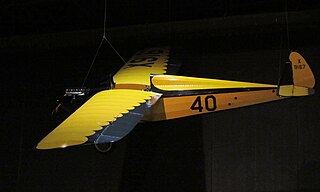
The Church Midwing JC-1, a.k.a. Church Mid-Wing Sport, is a midwing racing aircraft designed by James Church using the fuselage of a Heath aircraft.

The Salvay-Stark Skyhopper I is a low-wing single-place homebuilt aircraft designed in 1944.
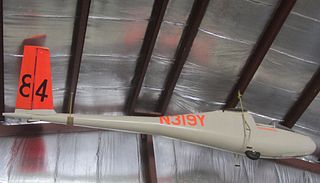
The Schreder Airmate HP-10 is an American, high wing, single seat, FAI Standard Class glider that was designed by Richard Schreder. Airmate was the name of Schreder's design company.
The Explorer PG-1 Aqua Glider is an American single seat, biplane glider that was designed by Bill Skiliar in 1959 and made available as plans for amateur construction. The prototype was built with help from a troop of Air Explorer Scouts that same year.

The Folkerts SK-2, also known as Speed King Two, "Toots" and "Miss Detroit" was a racer built for the 1936 National Air Races
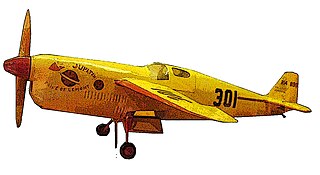
The Folkerts SK-3 a.k.a. "Jupiter, Pride of Lemont" was the third in a series of air racers developed by Clayton Folkerts.
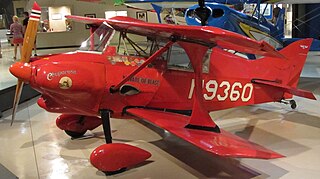
The Hegy "El Chuparosa" is a homebuilt, enclosed-cockpit biplane that was designed in the early 1950s.
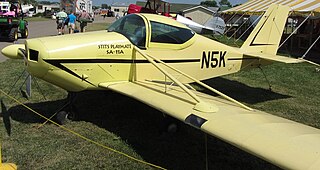
The Stits SA-11A Playmate is a homebuilt aircraft design that features a rapid wing-folding mechanism for trailering or storage.
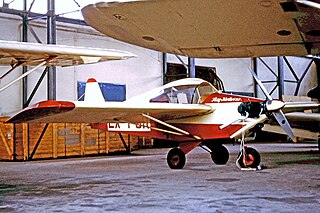
The Stits SA-5 Flut-R-Bug is a homebuilt aircraft designed by Ray Stits.

The RV-1 is a Stits Playboy that was constructed with modifications by Richard VanGrunsven. The aircraft was the first of a series of Van's aircraft that became the most popular homebuilt aircraft produced.

The Stits DS-1 Baby Bird is a homebuilt aircraft built to achieve a "world's smallest" status. The Baby Bird is in the Guinness Book of World Records as the “Smallest Airplane in the World.” as of 1984. The title was later defined as "world's smallest monoplane" to acknowledge Robert H. Starr's Bumble Bee as the world's smallest biplane.
The Rayner Pusher is a homebuilt version of the Curtiss Pusher.


















